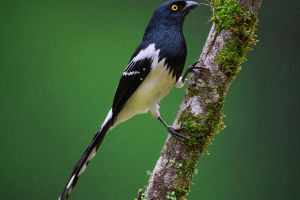Jellyfish, these ancient marine creatures, may appear fragile, but their vitality and biological characteristics are truly astounding.
Jellyfish belong to the phylum Cnidaria and are among the oldest creatures on Earth, having appeared in the ocean over 500 million years ago.
Despite their simple body structure, which is mostly composed of water, jellyfish play a crucial role in the ecosystem. Today, let's explore some interesting facts about jellyfish.
1. Jellyfish are mostly water
Jellyfish are composed of more than 95% water. In comparison, the human body is about 60% water.
This high water content makes jellyfish nearly "transparent," and they are almost impossible to distinguish while swimming in the ocean. Their "umbrella" structure is the main part of their body, responsible for controlling buoyancy and movement, while their tentacles serve the functions of hunting and defense.
2. Jellyfish have no brain
Surprisingly, jellyfish do not have a brain. While they can sense environmental changes and respond to them, jellyfish lack a central nervous system. Their neural tissue is called a "nerve net," which is spread throughout their body.
This nerve net helps them react to external stimuli, such as swimming, hunting, and avoiding danger. In simple terms, jellyfish behave like creatures controlled by a program; their actions are coordinated by nerve cells spread across their body, rather than being directed by a brain.
3. Jellyfish's "stingers"
The tentacles of jellyfish contain many tiny stinging cells called "cnidocytes," which are their primary weapon for defense and hunting. These cnidocytes can release a powerful toxin to capture prey or defend against predators.
When touched, the stinging cells are triggered and rapidly release toxins, rendering the prey immobile. The potency of jellyfish venom varies greatly between species, with some jellyfish possessing toxins capable of causing serious harm or even death to humans. The most famous example is the box jellyfish, whose venom can cause cardiac arrest in a short period.
4. Life cycle
The life cycle of a jellyfish is full of transformation, consisting of four main stages: zygote, larva, medusa (adult jellyfish), and polyp. Jellyfish have an extremely complex life cycle, and some species can even "regenerate" to revert to a younger state.
This regeneration phenomenon usually occurs later in a jellyfish's life, when its size and life cycle enter a cyclical state, allowing it to "reverse age" and return to the larval stage. This biological characteristic makes them highly adaptable in evolution.
5. Jellyfish need almost no food
The body structure of jellyfish makes them highly efficient predators. They capture small planktonic organisms, such as planktonic shrimp, fish larvae, and even other small jellyfish, with their tentacles.
Jellyfish do not chew their food but instead draw prey into their stomach cavity, where digestive fluids break it down. In this process, jellyfish require very little energy to hunt because their toxins and hunting methods make food capture highly efficient.
6. Jellyfish's "group" life
Although jellyfish seem like solitary creatures, they sometimes form large groups. These groups, called "jellyfish blooms" or "jellyfish chains," can create massive and stunning sights in the ocean.
Jellyfish blooms often consist of thousands of jellyfish, working together to drift on the ocean's surface. This group behavior not only helps jellyfish search for food across vast areas but also enables them to better fend off predators.
7. Global distribution
Jellyfish inhabit nearly all the oceans on Earth. Whether in warm tropical seas or cold polar waters, jellyfish can survive.
They are highly adaptable to environmental changes and can thrive under a wide range of conditions. Furthermore, jellyfish have an extensive distribution, and some species can even drift to shore, becoming a danger to people.
The simple structure and complex behaviors of jellyfish make them highly valuable for research. By understanding these fascinating facts, we can not only gain a better understanding of their ecological role but also develop a deeper respect for these mysterious marine creatures.


